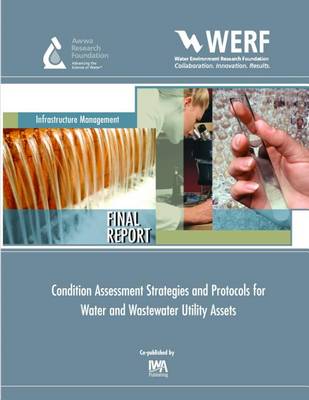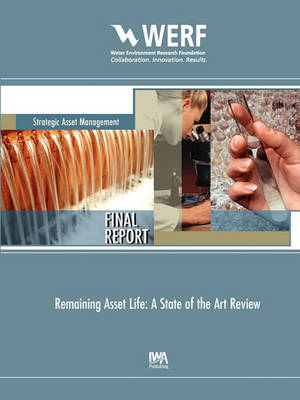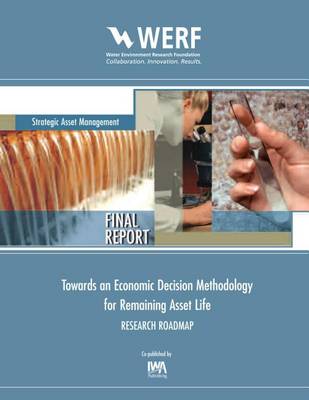WERF Research Report
4 total works
Protocols for Assessing Condition and Performance of Water and Wastewater Assets
by Anthony Urquhart
Published 30 April 2008
This report will only be available as a Pay-Per-View item.
The purpose of this research was to provide a road map for the effective use of condition and performance assessment tools and techniques by water and wastewater utilities within the context of different asset management sophistication levels. Generic approaches to assessment program design and tool selection are offered, which can be applied across a range of asset types.
The recommended approach to assessment program development draws on various protocols reviewed in the research and case study examples from leading utilities throughout the world and is aligned with the best practice concept that condition assessments should ideally be undertaken only when required to fill a specific gap in asset-related information to improve decision-making. The recommended tool selection approach uses an exclusion process in which tools are excluded on the basis of criteria relating to technical feasibility, technical suitability and utility technical capacity. Useable options must then be evaluated through economic or financial analysis such that final tool selection is made with regard to available resources, the cost-benefits accrued and utility affordability issues.
This research provides descriptions and reviews of 83 individual condition assessment tools and techniques used in the water and wastewater industry, including a discussion of principles, applications, practical considerations, advantages and limitations. A prototype expert system was developed to facilitate the selection of condition assessment tools using software systems. Such an expert system could provide a framework for updating, maintaining and distributing refinements of these tool reviews as condition assessment technologies and understanding advance in the future.
The purpose of this research was to provide a road map for the effective use of condition and performance assessment tools and techniques by water and wastewater utilities within the context of different asset management sophistication levels. Generic approaches to assessment program design and tool selection are offered, which can be applied across a range of asset types.
The recommended approach to assessment program development draws on various protocols reviewed in the research and case study examples from leading utilities throughout the world and is aligned with the best practice concept that condition assessments should ideally be undertaken only when required to fill a specific gap in asset-related information to improve decision-making. The recommended tool selection approach uses an exclusion process in which tools are excluded on the basis of criteria relating to technical feasibility, technical suitability and utility technical capacity. Useable options must then be evaluated through economic or financial analysis such that final tool selection is made with regard to available resources, the cost-benefits accrued and utility affordability issues.
This research provides descriptions and reviews of 83 individual condition assessment tools and techniques used in the water and wastewater industry, including a discussion of principles, applications, practical considerations, advantages and limitations. A prototype expert system was developed to facilitate the selection of condition assessment tools using software systems. Such an expert system could provide a framework for updating, maintaining and distributing refinements of these tool reviews as condition assessment technologies and understanding advance in the future.
This report is an output of the fourth research track (Track 4) of WERF's strategic asset management research program 'Asset Management Communication and Implementation' (SAM1R06). Track 4 addressed 'remaining asset life', and had the overall objective of contributing to the development of techniques, tools and methods for estimating residual life of wastewater assets. Track 4 research was planned to be undertaken in a staged manner, so as to provide a stepwise development of concepts and protocols.
To this end, the research team has produced a synthesis of knowledge in relation to "end of life" and "remaining asset life", which is the subject of this report. Drawing on the literature and the knowledge-base of the research team and industry partners, information is presented on the range of factors that influence the life of the different asset classes involved in the provision of wastewater services. A taxonomy of asset life is also given, along with a critical review of the conceptual linkages between risk, asset management and remaining asset life. A review of techniques used to assess remaining asset life is also included, as well as a detailed 'state of the art' review of modeling tools and approaches.
One of the key questions to be addressed in this initial stage of the research was the state of knowledge with respect to the estimation and prediction of remaining asset life, and if there is the capacity to translate between condition and performance data (e.g. the presence of significant defects) and the residual life of an asset. In this regard, this report builds on previous work undertaken by the research team into protocols for condition and performance assessments, as detailed in WERF (2007).
To this end, the research team has produced a synthesis of knowledge in relation to "end of life" and "remaining asset life", which is the subject of this report. Drawing on the literature and the knowledge-base of the research team and industry partners, information is presented on the range of factors that influence the life of the different asset classes involved in the provision of wastewater services. A taxonomy of asset life is also given, along with a critical review of the conceptual linkages between risk, asset management and remaining asset life. A review of techniques used to assess remaining asset life is also included, as well as a detailed 'state of the art' review of modeling tools and approaches.
One of the key questions to be addressed in this initial stage of the research was the state of knowledge with respect to the estimation and prediction of remaining asset life, and if there is the capacity to translate between condition and performance data (e.g. the presence of significant defects) and the residual life of an asset. In this regard, this report builds on previous work undertaken by the research team into protocols for condition and performance assessments, as detailed in WERF (2007).
Available as eBook only.
This report is an output of the fourth research track (Track 4) of WERF's strategic asset management research program 'Asset Management Communication and Implementation' (RFPP #06-SAM-1 CO). Track 4 was developed to address 'remaining asset life', with the overall objective of contributing to the development of techniques, tools and methods for estimating residual life of wastewater assets. Track 4 research was planned to be undertaken in a staged manner, so as to provide a stepwise development of concepts and protocols.
To this end, the research team previously produced a synthesis of knowledge in relation to "end of life" and "remaining asset life". This report builds on this material and presents a road map for building asset management capacity through the development of a practitioners guide to economic decision making.
This report is an output of the fourth research track (Track 4) of WERF's strategic asset management research program 'Asset Management Communication and Implementation' (RFPP #06-SAM-1 CO). Track 4 was developed to address 'remaining asset life', with the overall objective of contributing to the development of techniques, tools and methods for estimating residual life of wastewater assets. Track 4 research was planned to be undertaken in a staged manner, so as to provide a stepwise development of concepts and protocols.
To this end, the research team previously produced a synthesis of knowledge in relation to "end of life" and "remaining asset life". This report builds on this material and presents a road map for building asset management capacity through the development of a practitioners guide to economic decision making.
A Practitioner's Guide to Economic Decision Making in Asset Management
by David Marlow
Published 10 April 2015
For many water service providers (WSPs), meeting the financial demands of maintaining, extending and upgrading infrastructure systems is increasingly challenging. Furthermore, the remit of WSPs is broader than just financial considerations, so there is also a need to take societal impacts and values into account in the way investments are justified.
These challenges mean that there is an increasing need for asset managers to embrace new approaches to decision support. With this in mind, work has been undertaken to develop a 'Practitioner's Guidelines for Economic Decision Making'. The guidelines have been developed as an output of the fourth research track (Track 4) of WERF's strategic asset management research program 'Asset Management Communication and Implementation' (RFPP #06-SAM-1 CO). The guidelines are presented in two parts. Part I provides background discussions on concepts, frameworks and tools. The guidelines themselves are presented in Part II.
As discussed herein, economic decision making can only be achieved within a consistent policy framework that reflects stakeholder requirements and regulatory and other business constraints. Insights into how such a framework can be developed are therefore provided. The guidance also includes a logical way of classifying and structuring different types of asset management decisions. In all, six types of decision are identified and guidance provided on the development of methodologies for each. The Guidelines also summarize a range of other tools and approaches that can be used in support of economic decision making, including a range of tools developed by the research team. Importantly, the guidelines differentiate between economic decision making and economic analysis. Economic decision making should underpin all decisions made by WSPs, while economic analysis will only be required for a subset of decisions. To provide a practical grounding, the guidelines include case studies developed with industry partners in Australia, the UK and the USA.
A copy of the manual will be supplied to you and the order confirmed by email. This email is to be sent to Gina Street at WERF on gstreet@werf.org as proof of purchase and copy of the tool will be supplied to you at no additional cost.
These challenges mean that there is an increasing need for asset managers to embrace new approaches to decision support. With this in mind, work has been undertaken to develop a 'Practitioner's Guidelines for Economic Decision Making'. The guidelines have been developed as an output of the fourth research track (Track 4) of WERF's strategic asset management research program 'Asset Management Communication and Implementation' (RFPP #06-SAM-1 CO). The guidelines are presented in two parts. Part I provides background discussions on concepts, frameworks and tools. The guidelines themselves are presented in Part II.
As discussed herein, economic decision making can only be achieved within a consistent policy framework that reflects stakeholder requirements and regulatory and other business constraints. Insights into how such a framework can be developed are therefore provided. The guidance also includes a logical way of classifying and structuring different types of asset management decisions. In all, six types of decision are identified and guidance provided on the development of methodologies for each. The Guidelines also summarize a range of other tools and approaches that can be used in support of economic decision making, including a range of tools developed by the research team. Importantly, the guidelines differentiate between economic decision making and economic analysis. Economic decision making should underpin all decisions made by WSPs, while economic analysis will only be required for a subset of decisions. To provide a practical grounding, the guidelines include case studies developed with industry partners in Australia, the UK and the USA.
A copy of the manual will be supplied to you and the order confirmed by email. This email is to be sent to Gina Street at WERF on gstreet@werf.org as proof of purchase and copy of the tool will be supplied to you at no additional cost.



